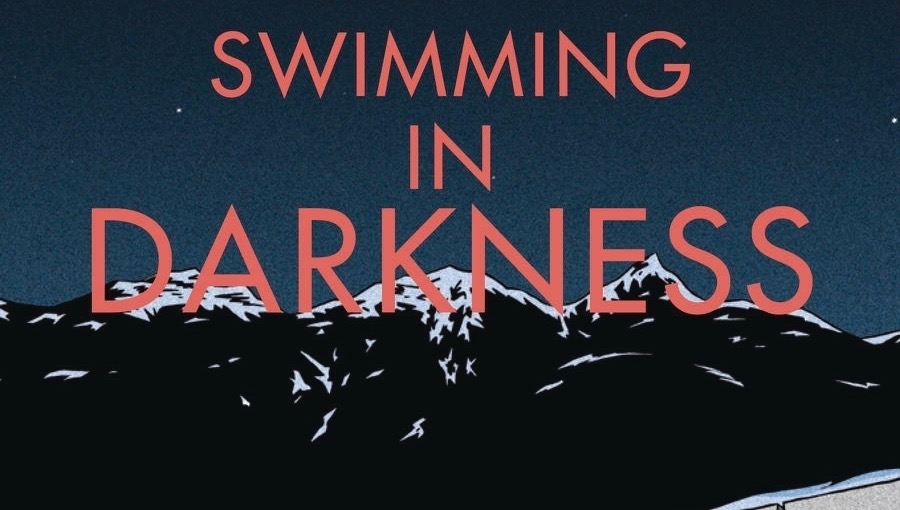The following is an interview with Lucas Harari regarding the upcoming release of his graphic novel, Swimming in Darkness, from Arsenal Pulp Press. In this interview, Fanbase Press Editor-in-Chief Barbra Dillon chats with Harari about the inspiration behind his debut graphic novel, his creative process in bringing the story to life, and more!
Barbra Dillon, Fanbase Press Editor-in-Chief: Congratulations on the upcoming release of your graphic novel, Swimming in Darkness, through Arsenal Pulp Press! For those who may be unfamiliar, how would you describe the book’s premise, and what inspired you to tell this story?
Lucas Harari: Thank you very much! Swimming in Darkness is my first graphic novel. It tells the story of Pierre’s journey to the heart of the Swiss Alps to visit the thermal baths of Vals, the famous building of the architect Peter Zumthor. Pierre, who feels a magnetic attraction to this place, will discover an ancestral legend, and penetrate into the heart of a mystery whose gateway is the architecture itself.
The idea for this book came from my own visit to this place at the age of 13. I was then following my parents, who are themselves architects, on their architectural pilgrimages. The experience was a shock to me! But it was only several years later that I developed the story based on my memories, because I never went back there afterwards. I simply projected onto my characters my own desires, my own fears, my own obsessions…
BD: Given that Swimming in Darkness blurs the boundaries between autobiography and fiction, how would you describe your creative process in both researching architect Peter Zumthor and crafting a psychological thriller that encompassed his work?
LH: There is a path in the book, literally and figuratively. We enter the story with my own father; then, we leave Paris, which is my city, my everyday life, to search for an elsewhere, an exoticism, an adventure, which is materialized by this place, Vals, which exists and which I know. So, I start writing with what I know and then add the genre elements: the fantastic, the noir fiction, and the thriller. But architecture, and reality, are the common threads that allow the reader to hold all this together, to legitimize our incursions into Pierre’s extraordinary adventure.
BD: What do you hope that readers will take away from the graphic novel?
LH: For me, the important thing is to be able to communicate with other works of art; here, it’s the architecture of Peter Zumthor. If readers can discover or rediscover this place—marvel over, be moved by, and desire this place—then that is magnificent. But it is true that when you work, you don’t necessarily think about the reader. Or you could say there is “ONE” reader who is both ourselves and another potential person. It’s so lonely when you make a comic book. It’s only later, when the book comes out, that you say, “Oh, there are people reading what I’ve done?!” and you’re sometimes surprised by certain reactions. People have already told me that they “jumped at this moment” in the text, and I find that incredible. And things like this make me very happy.
BD: In light of your education in architecture, do you feel that your knowledge of design easily translated to your work in sequential art and cartooning?
LH: Actually, I spent six months in architecture school. Not much to draw from. I learned a lot more about space and its representation when I saw my parents working and drew what I had in front of me: a chair, an ashtray, a lamp, a car…
It really comes from my taste for the objects I represent. And then, all the comic books I read as a child showed this kind of modernist universe; the “Ligne Claire” style in France and Belgium (created and pioneered by Hergé, the creator of The Adventures of Tintin) has had a lot of fun with modern architecture, such as the designs of the ’50s or the aerodynamic lines of the ’60s sports cars. I looked for a way to take this up on my own and stage it today.
And then, my narrative ideas often come from the way spaces are modulated. I must therefore be rigorous, so that when someone reads it, they understand these spaces well.
BD: Are there any upcoming projects on which you are currently working that you would like to share with our readers?
LH: Yes, I am working on a new graphic novel that will be released in France in September 2020. It will be titled The Last Rose of the Summer, and, once again, there will be several genre dimensions: crime thrillers, love stories, pulp fiction… It will take place in the summer at the seaside, full of beautiful architects’ villas, beautiful cars, pop music, and teenagers who disappear…. I hope that the book will also be translated into English.
BD: Lastly, what is the best way for our readers to find more information about Swimming in Darkness?
LH: You can follow me on Instagram: @lucas.harari.

